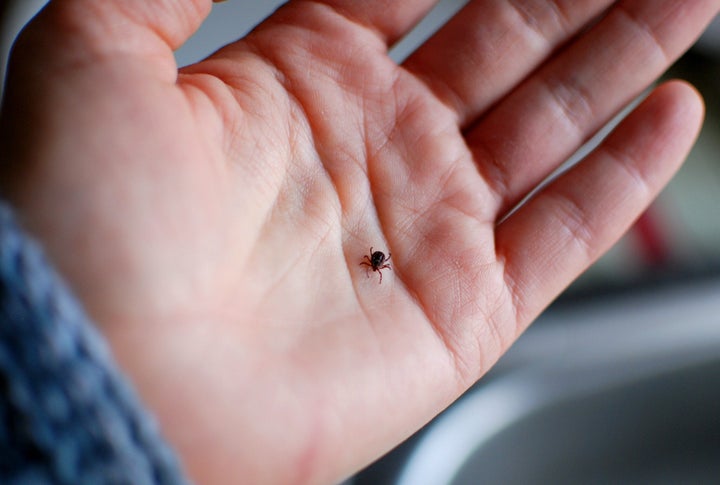
Warmer weather means more pesky insects we need to avoid, including ticks. Tick bites have been on the rise in recent years ― and there are a number of factors that likely contribute to this.
“Ticks thrive best in warmer conditions, so increasing temperatures, both in the summer and winter, may result in a greater number of ticks and tick bites,” said Matthew Aardema, an assistant professor of biology at Montclair State University.
Growing deer populations in certain parts of the country have also likely led to a greater number of ticks. And a larger proportion of people spending time outdoors engaged in activities like hiking or gardening, which have become popular pandemic era de-stressors, is another contributor to the increase in tick bites.
An increase in tick encounters can cause things like Lyme disease, which is also on the rise. In 2018, the Centers for Disease Control and Prevention reported 47,743 cases of tick-borne diseases. In 2019, the number rose to 50,865.
David Claborn, director of the Master of Public Health program at Missouri State University, said that in recent years, experts have been able to detect even more tick-borne diseases that were likely misdiagnosed in the past.
“For instance, in the southwest Missouri region, two viral diseases have been identified in the last 15 years: the heartland virus and the bourbon virus,” he said. “These are not necessarily new viruses; we just know what to look for now and have sophisticated tools with which to identify them.”
So how should you avoid tick bites, and what should you know about ticks in general? Here’s a guide.
What do ticks look like and where are ticks usually found?
“Ticks are found nearly everywhere with the exception of high mountains; however, they are most likely to be in areas with heavy brush and tall grass,” Claborn said.
They are especially abundant, he added, in ecotones, which are transitional areas from one dominant vegetation to another. For instance, the ecotone between heavily wooded areas to open meadow are particularly prime areas.
Ticks are very small, with adult ticks being about the size of an apple seed and the smallest tick being the size of a grain of sand. They’re tear-drop shaped with eight legs (the larva only have six legs).
How can you tell if there are ticks in your area?
“If you don’t already experience it firsthand by seeing them on your companion animals, family or yourself, there are a couple of resources,” said Jean Tsao, an associate professor in Michigan State University’s Department of Fisheries and Wildlife.
She directs people to the CDC’s “Regions where ticks live” website for a breakdown of the different types of ticks and where they are most prevalent.
“If you live in a state that has active tick surveillance, your state health department’s website might have more detailed information, too,” Tsao added. And this CDC page has maps for certain tick species, as well the risks of exposure to ticks infected with the Lyme disease bacteria.
Tick Encounter also provides information about ticks, and has a Tick Finder Map where people can submit photos of ticks in their region and share which varieties might be active in their geographic region at a particular time.
“Experts are IDing the photos and collating the information, so it’s reliable,” Tsao said.

How do you prevent tick bites?
There are a few methods you should practice. First, Aardema suggested wearing pants and socks that cover the ankles and lower legs when hiking outside.
“When practical, pant legs can be tucked into the socks to prevent ticks gaining access to the skin,” he explained. “However, this may mean that ticks will try crawling higher up the body.”
Opt for lighter-colored clothing, which makes it easier to see ticks before they start biting. And don’t forget your insect repellent.
“Apply a bug spray with at least 25% DEET to your clothing, especially the shoes and pant legs,” said Aardema, who noted that non-DEET products have not been shown to be effective at preventing tick bites.
“A tick searching for a place to bite is much easier to remove than a tick that has already started feeding, so check for ticks frequently during hikes or whenever spending an extended amount of time outdoors,” Aardema added.
And after spending any time outside in tick-prone areas, you should thoroughly check for ticks on your body. Aardema said to do this even in the winter, if temperatures are above freezing.
It’s important to inspect all areas of your body, including the scalp, behind the ears, under the arms, in the groin area, inside the belly button and behind the knees, added Jeannie Kenkare, chief medical officer at PhysicalOne Urgent Care. “Take a shower if possible to help remove any ticks that have not yet latched on,” she said.
Your dog or cat may also carry ticks in from the outdoors, even if they wear a flea and tick collar. Rachel Rubin, co-lead of the Cook County Department of Public Health in Illinois, said to run your fingers through your pet’s fur with gentle pressure to feel for any small bumps. Look in and around the ears, under the collar, between their legs, toes and around the tail.
You can also perform some maintenance in your yard to minimize your chances of tick encounters. Karen Reardon, VP of Public Affairs with RISE ― a national trade association dedicated to specialty pesticides and fertilizers ― recommended removing leaves, brush and weeds and trimming shrubs and trees around the perimeter of your home and edge of your lawn.
“Use pesticides around your home’s perimeter and as a targeted barrier treatment,” she said. You can also hire a professional to treat your yard with an effective insect repellent, she added.
How can you tell if you have a tick bite?
A tick bite might go unnoticed if the tick is no longer attached and if it does not cause any immunological reaction, like if the area is not itchy or does not cause a rash.
“Tick bites generally are not itchy and do not cause rashes on their own, but if some people have been bitten by ticks in the past, their bodies might mount an immune response to the salivary proteins of a tick bite because the immune system has seen those proteins before and has created antibodies,” Tsao said. “So, the bite site might be itchy and there might be redness, just as they might to a mosquito bite.”
If the tick transmits a pathogen such as the Lyme disease bacterium, there may be a circular rash, which is also described as a “bull’s-eye rash” that grows from the tick bite. Tsao said that if an American dog tick or a Gulf Coast tick transmits a spotted fever to you, you might have a different kind of rash.

Should you remove a tick if it’s embedded into your skin?
Tsao said yes, you should always remove a tick that’s biting you. “If the tick is infected, the longer it’s attached, the higher the probability that it will transmit the pathogen to you,” she explained. And the sooner you remove the tick, the greater the chance that you will prevent transmission.
To remove a tick, Tsao said to use a fine-tipped pair of tweezers to grasp the tick as close to the skin as possible. Then, pull up on the tick with even steady motion (without twisting or rapid movements).
“If small parts of the tick break off and remain in the skin — remove them if easily removed, but otherwise just leave it alone and the body will push it out over time,” she said. Try not to squeeze the body of the tick as you grasp it, as this could make it more likely for the tick to infect you.
And stay away from other DIY removal strategies. “We often hear of people using petroleum jelly or matches to kill the tick while it is attached to the skin. This is not effective and may of course cause much more harm to the skin,” said Andrew S. Handel, an assistant professor of pediatric infectious diseases at Stony Brook Children’s Hospital.
After removing the tick, Tsao said to wash the area with soap and water or alcohol. She suggested saving the tick so that if you do become sick, it can be used for identification by the physician to determine the course of diagnosis and treatment. This can be especially important, as different tick species transmit different pathogens. Take clear photos of the tick and send them to Tick App or Tick Spotters to have experts ID the tick for you.
What should you do after a tick bite?
If you have removed a tick, Kenkare said it’s important to monitor for symptoms for at least two weeks.
“The most common symptoms of illness related to tick bites include fever or chills, fatigue and body aches,” she said. A rash is also a sign that you should seek out medical treatment.
Additionally, the site of a bite can become infected, so watch for any redness, swelling or increasing pain. “If you develop any of these symptoms after a tick bite, you should immediately seek out medical care from your primary care or from your local urgent care,” Kenkare said.
While Lyme disease is the most common infection transmitted by ticks, there are other illnesses that can also come from tick bacteria. “These illnesses often present with similar symptoms including fever, fatigue, headache, nausea and vomiting and all require medical attention,” Kenkare explained.
But just because you’ve been bitten, it doesn’t necessarily mean you’re infected. “While tick bites are always concerning to me as an urgent care physician, it’s important to remember that not all ticks carry disease,” Kenkare said. “A medical professional can thoroughly examine the bite, the story and the conditions surrounding it to determine if any further testing or treatment is needed.”